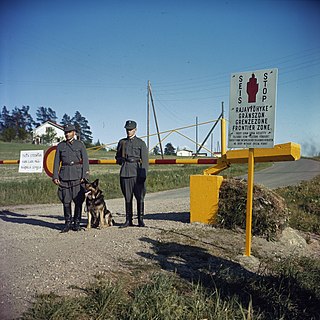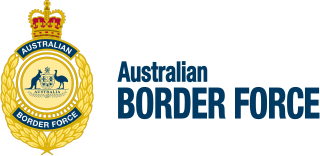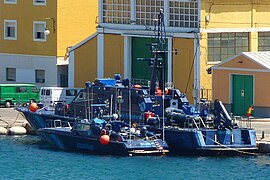
Smuggling is the illegal transportation of objects, substances, information or people, such as out of a house or buildings, into a prison, or across an international border, in violation of applicable laws or other regulations. More broadly, social scientists define smuggling as the purposeful movement across a border in contravention to the relevant legal frameworks.

The Trinidad and Tobago Defence Force (TTDF) is the military organisation responsible for the defence of the twin island Republic of Trinidad and Tobago. It consists of the Trinidad and Tobago Regiment, the Trinidad and Tobago Coast Guard, the Trinidad and Tobago Air Guard and the Defence Force Reserves.

A coast guard or coastguard is a maritime security organization of a particular country. The term embraces wide range of responsibilities in different countries, from being a heavily armed military force with customs and security duties to being a volunteer organization tasked with search and rescue without law enforcement authority. In most countries, a typical coast guard's functions are distinct from those of the navy and the transit police, while in certain countries they have similarities to both.

United States Customs and Border Protection (CBP) is the largest federal law enforcement agency of the United States Department of Homeland Security. It is the country's primary border control organization, charged with regulating and facilitating international trade, collecting import duties, as well as enforcing U.S. regulations, including trade, customs and immigration. CBP is one of the largest law enforcement agencies in the United States. It has a workforce of more than 45,600 federal agents and officers. It is headquartered in Washington, D.C.
SVA is an initialism that may refer to:

The Australian Customs and Border Protection Service was an Australian federal government agency responsible for managing the security and integrity of the Australian border and facilitating the movement of legitimate international travellers and goods, whilst protecting the safety, security and commercial interests of Australians.

Water police, also called bay constables, coastal police, harbor patrols, marine/maritime police/patrol, nautical patrols, port police, or river police are a specialty law enforcement portion of a larger police organization, who patrol in water craft. Their patrol areas may include coastal tidal waters, rivers, estuaries, harbors, lakes, canals or a combination of these.

The Pakistan Coast Guards is a maritime law enforcement agency of the Civil Armed Forces of Pakistan. It is managed and controlled by the Pakistan Army, with a mission of riverine operations and coastal operations including conducting anti-narcotics missions, anti-human trafficking, illegal immigration through the coastal areas, and anti-smuggling initiatives.

The National Republican Guard or GNR is the national gendarmerie force of Portugal.

A border guard of a country is a national security agency that performs border security. Some of the national border guard agencies also perform coast guard and rescue service duties.

Air and Marine Operations (AMO) is a federal law enforcement component within U.S. Customs and Border Protection (CBP), an agency of the United States Department of Homeland Security (DHS). AMO's mission is to protect the American people and nation's critical infrastructure through the coordinated use of air and marine assets to detect, interdict and prevent acts of terrorism and the unlawful movement of people, illegal drugs, and other contraband toward or across the borders of the United States. Air and Marine Operations Agents and Officers are endowed with the authority to enforce Title 8 and Title 19 (Customs) of the United States Code in addition to the general law enforcement powers bestowed upon federal law enforcement agents.

There is officially no Air Force of Costa Rica; the only air wing in existence is attached to the Public Force of Costa Rica. Currently this unit, officially called Air Vigilance Service, also called the Air Service, does not operate any armed military aircraft. Its main air bases located in three different points, San José being the main operations center.
The Australian Patrol Boat Group is a Force Element Group (FEG) of the Royal Australian Navy. It manages the Navy's patrol boats.

The Marine Unit, formerly the Australian Customs Service National Marine Unit, is a division of the Australian Border Force which acts as a Coast Guard in guarding Australia's coast. The Marine Unit focuses on surveillance and response activities within the Australian Economic Exclusion Zone, and the operation and training of ships and crews to do so.

The Directorate-General of Customs and Indirect Taxes, commonly known as les douanes (Customs), is the customs service of the French Republic. It is responsible for levying indirect taxes, preventing smuggling, surveilling borders and investigating counterfeit money. The agency acts as a coast guard, border guard, sea rescue organisation, and customs service. In addition, since 1995, the agency has replaced the Border Police units of the National Police in carrying out immigration control at smaller border checkpoints, in particular at maritime borders and regional airports.

The Puerto Rico Joint Forces of Rapid Action —Spanish: Fuerzas Unidas de Rapida Acción (FURA)— is an agency within the Puerto Rico Police in charge of specialized divisions that relate to federal law enforcement agencies of the United States, and coordinate operations between the PRPD and U.S. federal agencies. The force is a limited unit, well trained, and well recognized in the police. The force collaborates with law enforcement agencies of the federal government of the United States such as the Federal Bureau of Investigation, the Bureau of Alcohol, Tobacco, Firearms and Explosives, the United States Marshals Service, and the Department of Homeland Security among others.

The Australian Border Force (ABF) is a federal law enforcement agency, part of the Department of Home Affairs, responsible for offshore and onshore border enforcement, investigations, compliance, detention operations and customs services in Australia. Through the ABFs Marine Unit, the ABF performs Coast Guard and marine law enforcement duties and is a component of the Maritime Border Command. The ABF is also part of the National Intelligence Community and is an active member of the World Customs Organization.

The Indonesian Sea and Coast Guard Unit is an agency of Government of Indonesia which main function is to ensure the safety of shipping inside the Indonesian Maritime Zone. KPLP has the task of formulating and execute policies, standards, norms, guidelines, criteria and procedures, as well as technical guidance, evaluation and reporting on patrol and security, safety monitoring and Civil Service Investigator (PPNS), order of shipping, water, facilities and infrastructure of coastal and marine guarding. KPLP is under the Directorate General of Sea Transportation of the Indonesian Ministry of Transportation. Therefore, KPLP reports directly to the Minister of Transportation of the Republic of Indonesia. KPLP is not associated or part of the Indonesian National Armed Forces. KPLP, however often conduct joint-exercise and joint-operations with the Indonesian Navy.

The ship Life is a former fishing cutter, which was used in the Mediterranean from 2017 to 2018 under the name Seefuchs for the Sea-Eye association from Regensburg as a rescue ship between Malta and Libya. In 2019 the ship was given away to the Spanish organisation Proem-Aid. In 2021, the ship was intercepted in international waters with a large drug load after being bought by drug dealers, in a joint investigation by the Guardia Civil and the Servicio de Vigilancia Aduanera.




























